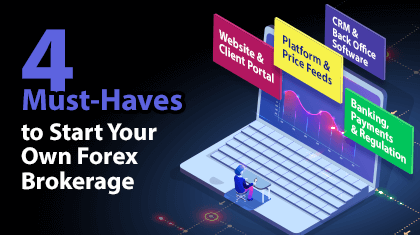
A Quick Guide to NFTs
March 26, 2021
3 Ways to Keep Your Best Sales & Retention Staff
April 12, 2021
Online trading has come a long way in the past two decades. At PandaTS, we’ve spent a lot of time on the B2B side, simplifying the process of launching a new brokerage business by developing a suite of products that can either be purchased as a brokerage-in-a-box solution, or as individual components that prospective clients can pick and choose from.
We’re often asked to provide a simple overview of all the different components required to start a brokerage from scratch. We thought we’d create one here on our blog that we can refer people back to. So, read on for 4 must-haves if you want to start your own FX brokerage!
1. Website & Client Portal
Let’s start with the easiest things first. In order to promote your services, attract new clients, and build your brand, you’ll need some online real estate. Your website serves two distinct purposes. The first is to be your storefront in the online world. This is where incoming traffic can find out more about your company and your trading offering. The second is a portal through which registered clients can interact with your services. The first is a purely front-end affair, the other is necessarily connected to your back-end systems and is accessible to your clients only after they have registered an account with you.
A key thing to consider here, is that if your client portal doesn’t play well with your back-end systems, you’ll always be running into problems down the line and your staff will find it difficult to coordinate with each other in an efficient manner.
2. Platform & Price Feeds
With your website and client portal covered, you will need a platform for your clients to trade on and price feeds of all the various assets you plan to offer. Similar to your website, your platform infrastructure also breaks down into a front- and a back-end. The front end is the charting interface that your clients log into and browse different markets before entering positions. The back-end is the dealing and risk management infrastructure that helps your business keep on top of all the trades you’ve brokered and the markets you’re exposed to as a result.
Full licenses can be purchased directly from a provider like MetaQuotes, or as a branded white label solution from a third-party provider. New brokers tend to start with white label solutions, as they are the more cost-effective option of the two.
If you’re passing your incoming trades on to a liquidity provider, you’ll receive your price feeds directly from them and will have to connect to their systems via a standardised protocol like FIX. If you’re internalising your trades, you’ll need an accurate, reliable and spike-free reference feed for all the markets you plan to offer from a reputable provider.
3. CRM & Back Office Software
For all of your staff’s efforts behind the scenes to be coordinated, common systems are required that allow you to manage all the individual relationships between your clients and your company. This includes where they are in the conversion funnel. Have they supplied KYC/AML documents? Have they deposited yet? Are they high net worth?
A CRM, or customer relationship management system, is what allows your various departments to have easy access to all this information and more. Your CRM will naturally overlap with and connect to other systems being used by your marketing department, for instance, or compliance. The important thing to keep in mind is interoperability. Your CRM is basically the brains of your operation, so a badly designed CRM that cannot speak to marketing, or that’s a pain to navigate by your back office staff, means that your business as a whole is slower and less intelligent than it could be.
4. Banking, Payments & Regulation
We’ve lumped these three things into one point as each is contingent on the others. To obtain banking relationships, you will need to be licensed by the financial regulator of the jurisdiction you’re planning to base your operations in. Then, for your brokerage to be able to conduct business, it will not only need corporate accounts, but also PSP (payment service provider) relationships, allowing your company to process debit and credit cards from a wide variety of locations.
This process can be complicated as the regulations regarding online trading vary from one jurisdiction to the next, as do the costs and requirements of obtaining regulation in different countries or regions. Read our regulation primer here for more info. Also, care is required in the selection of PSPs as they are a business-critical component that must be entrusted with large amounts of capital.
In Summary
This has been a very high-level overview of what’s required to start an online FX brokerage. There’s more to it than just websites, platforms, CRMs and banking, but it’s enough to get you thinking. At Panda we have pioneered a modular system of products and services that make the setup of a modern online brokerage quick and easy. We have also developed many useful relationships over the years with PSPs, IB networks and corporate service providers, allowing us to offer a true turnkey solution. If you’d like to find out more, please get in touch with one of our success managers.
For free consultation
Request a Call
